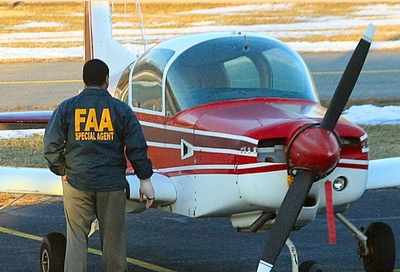Fri, Aug 21, 2015
For Recreational Flyers A Ramp Check Can Sound Scary, But If You Know The Rules It’s No Big Deal
Most Federal Aviation Regulations make sense because they are aimed at aviation safety, and while some of the safety related rules may seem arbitrary, it could be said they are well intended. Other rules may not be safety related, and they are usually rules that require pilots to show compliance with the regulations. This is what a ramp check is all about

When we use the term ramp check, we are not talking about the unfortunate cases of pilots being approached and questioned by military uniformed personnel from various government agencies. What we are reviewing is the simple case of an FAA operations inspector walking up in civilian clothes, shaking your hand, and announcing that you’re about to receive a ramp check.
The purpose of the ramp check is to verify that the pilot and aircraft are in compliance with the certification regulations. In other words, your paperwork had better be in order. Let’s review what must be with you when you act as a pilot-in-command (PIC).
The pilot must have the following items in his or her possession and must present them upon request by an FAA or law enforcement official:
- FAA pilot certificate.
- Government issued photo identification. This is commonly a state driver’s license, but other government issued photo identification is acceptable.
- Proof of appropriate medical certification. For a sport pilot or sport pilot student, this could be an FAA medical certificate or a valid state driver’s license.
- A student pilot must have his or her logbook on cross country flights, and a sport pilot must have either his or her logbook with the appropriate sport pilot endorsements or a record of the endorsements. Recreational pilots must also have proof of endorsement for extended cross-country flying and tower controlled airspace training if they had received those endorsements.
- Private and higher-rated pilots are not required to carry logbooks with them, and that’s probably a pretty good idea. However the FAA inspector may ask you to present some sort of proof of appropriate endorsements, such as a flight review, within a reasonable period of time.
The aircraft must also have certain papers to be legal to operate. They are:
- The airworthiness certificate must be onboard and must be displayed so that it is visible in the cockpit.
- The registration certificate has be onboard the aircraft and the address and ownership information on record with the FAA must be accurate and up-to-date. Remember, the registration certificate must be renewed every 3 years.
- The operating limitations must be onboard the aircraft. This could be part of the aircraft operating handbook or it could be a separate document, such as with experimental aircraft, and it may also certain include placards.
If you want the actual details of what the FAA inspector is authorized to do on a ramp check, it’s found in FAA Order 8900.1, Chapter 1, Section 4, and Titled: Conduct a FAR Part 91 Ramp Inspection.
With a little preparation and a calm demeanor, receiving a ramp check is not that big of a deal.
(Image from file)
More News
With Testing Soon Complete, Launch Preparations Begin in Earnest Sierra Space's Dream Chaser has been put through the wringer at NASA's Glenn Armstrong Test Facility in Ohio, but w>[...]
Takeoff Roll The process whereby an aircraft is aligned with the runway centerline and the aircraft is moving with the intent to take off. For helicopters, this pertains to the act>[...]
“We’re proud of the hard work that went into receiving this validation, and it will be a welcome relief to our customers in the European Union. We couldn’t be mor>[...]
"Aircraft Spruce is pleased to announce the acquisition of the parts distribution operations of Wag-Aero. Wag-Aero was founded in the 1960’s by Dick and Bobbie Wagner in the >[...]
IDENT Feature The special feature in the Air Traffic Control Radar Beacon System (ATCRBS) equipment. It is used to immediately distinguish one displayed beacon target from other be>[...]
 Sierra Space Repositions Dream Chaser for First Mission
Sierra Space Repositions Dream Chaser for First Mission ANN's Daily Aero-Term (05.10.24): Takeoff Roll
ANN's Daily Aero-Term (05.10.24): Takeoff Roll Aero-News: Quote of the Day (05.10.24)
Aero-News: Quote of the Day (05.10.24) Aero-News: Quote of the Day (05.11.24)
Aero-News: Quote of the Day (05.11.24) ANN's Daily Aero-Term (05.11.24): IDENT Feature
ANN's Daily Aero-Term (05.11.24): IDENT Feature



